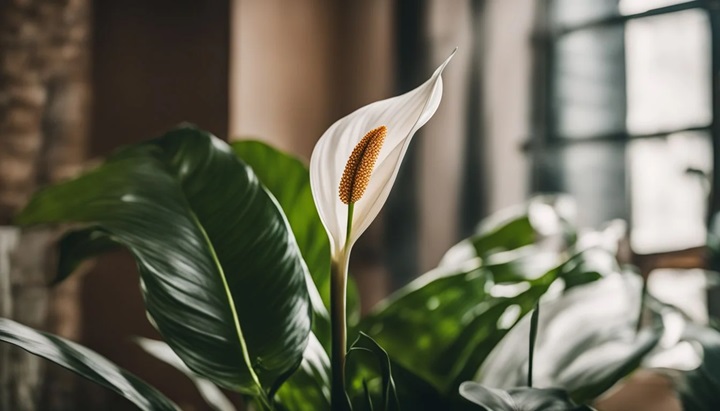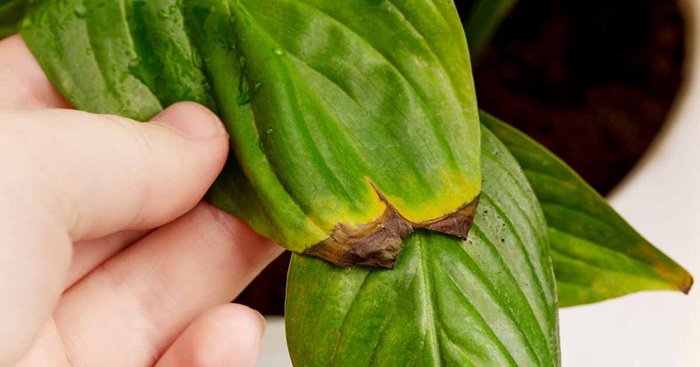Peace lilies (Spathiphyllum) are one of the most popular indoor plants due to their beautiful, glossy leaves and striking white blooms. They are often favored by both novice and experienced plant lovers because of their ability to thrive in low-light conditions and their air-purifying qualities. However, even the most robust plants can encounter issues, and one of the most common problems peace lily owners face is brown tips on the leaves. While it may not always signify a serious issue, brown tips can be unsightly and may indicate underlying health concerns for your plant.
In this comprehensive guide, we will explore the reasons why peace lilies develop brown tips, how to address this issue, and how to prevent it in the future.
Understanding Brown Tips on Peace Lilies
Before delving into the causes and solutions, it’s essential to understand what brown tips on peace lilies signify. When the tips of a peace lily’s leaves turn brown, it usually indicates stress or damage to the plant. This browning typically starts at the edges of the leaves and can progress if the underlying problem is not addressed.
Why Should You Care About Brown Tips?
While brown tips do not immediately threaten the survival of your peace lily, they are a visible sign that something is not quite right. If left unchecked, the issue causing the brown tips could worsen and lead to more significant health problems for your plant, such as wilting, yellowing, or even the death of the plant in extreme cases.
Common Causes of Brown Tips on Peace Lilies
Several factors can cause brown tips on peace lily leaves. Understanding these causes is the first step toward diagnosing and solving the problem.
1. Overwatering or Underwatering
The most common reason for brown tips on peace lilies is improper watering. Peace lilies prefer consistently moist soil, but not waterlogged or overly dry conditions. Overwatering can lead to root rot, while underwatering can cause the plant to dry out, resulting in brown tips.
Signs of Overwatering:
- Yellowing leaves in addition to brown tips.
- Soggy soil with poor drainage.
- A foul odor from the soil (a sign of root rot).
Signs of Underwatering:
- Crisp, dry leaf edges.
- Soil that feels dry to the touch even after regular watering.
Solution:
- Ensure the peace lily’s soil is well-draining and avoid letting it sit in water. Water the plant when the top inch of the soil feels dry but do not let the soil completely dry out. Peace lilies typically need watering about once a week, but this may vary depending on the environment.
2. Low Humidity
Peace lilies are tropical plants that thrive in humid environments. When the air around your plant is too dry, especially in winter when indoor heating systems are running, the plant can develop brown leaf tips.
Solution:
- Increase the humidity around your peace lily by misting the leaves regularly with water or placing the pot on a tray filled with water and pebbles. You can also use a humidifier in the room where the plant is located, which can be beneficial for both the plant and humans.
3. Exposure to Direct Sunlight
Peace lilies prefer low to medium light conditions and do not tolerate direct sunlight. Exposure to intense, direct sunlight can scorch the leaves, leading to brown tips or brown patches on the leaves.
Solution:
- Move your peace lily to a location with bright, indirect light. A spot near a north- or east-facing window is ideal. Avoid placing the plant in a window where it will receive direct sun rays, especially during the hottest part of the day.
4. Fertilizer Burn
Over-fertilization or the use of harsh chemical fertilizers can cause brown tips on peace lily leaves. Excess salts from fertilizers can accumulate in the soil, drawing moisture away from the roots and causing the tips of the leaves to turn brown.
Solution:
- If you suspect fertilizer burn, flush the soil with water to remove excess salts. You can do this by watering the plant thoroughly and allowing water to drain out of the bottom of the pot. Reduce the frequency of fertilizing to once every 2-3 months, and always use a balanced, diluted fertilizer.
5. Water Quality
The type of water you use for your peace lily can also cause brown tips. Tap water often contains chemicals such as chlorine and fluoride, which can accumulate in the soil and cause leaf damage.
Solution:
- Use filtered or distilled water to avoid these harmful chemicals. You can also allow tap water to sit out for 24 hours before using it to let some of the chemicals dissipate.
6. Pests and Diseases
Although less common, pests such as spider mites or mealybugs can damage peace lilies, leading to brown tips or spots on the leaves. Root rot, caused by fungal infections, is another disease that can cause browning of the leaves.
Solution:
- Inspect the plant for pests regularly. If you notice tiny bugs or webs, treat the plant with insecticidal soap or neem oil. For fungal infections, repot the plant in fresh, well-draining soil and prune away any affected roots.
How to Treat Brown Tips on Peace Lilies
Once you’ve identified the cause of the brown tips, the next step is to treat your peace lily and nurse it back to health. Here are some steps you can follow to improve the appearance of your plant:
1. Pruning the Affected Leaves
If the browning is only affecting the tips of a few leaves, you can carefully trim off the brown edges with a pair of sharp, clean scissors. Be sure to cut just along the edge of the healthy, green part of the leaf. If entire leaves have turned brown, it’s best to remove them entirely to encourage new growth.
2. Adjust Your Watering Routine
Monitor the moisture level of the soil more carefully. Ensure that you are not over- or under-watering your peace lily. If your plant is sitting in waterlogged soil, consider repotting it in fresh soil with better drainage.
3. Improve Humidity
As mentioned earlier, increasing the humidity around your peace lily can help prevent further browning of the tips. Grouping plants together, misting the leaves, or using a pebble tray can all be effective methods for raising humidity.
4. Leach the Soil
If you suspect that fertilizer or water salts are the cause of the brown tips, you can leach the soil by watering it thoroughly and allowing excess water to drain away. Repeat this process several times to flush out any accumulated salts or chemicals.
Preventing Brown Tips on Peace Lilies
Prevention is always better than cure. Once you have restored your peace lily’s health, taking the following precautions can help prevent future occurrences of brown tips:
1. Create an Ideal Environment
Place your peace lily in a location that receives bright, indirect light. Avoid spots near windows where the plant could be exposed to direct sunlight. Keep your plant in a room with consistent humidity levels and avoid placing it near air vents or radiators.
2. Follow a Regular Watering Schedule
Consistency is key when it comes to watering peace lilies. Stick to a regular schedule based on the moisture level of the soil. Water when the top inch of the soil is dry and ensure that the pot has proper drainage to prevent water from accumulating at the roots.
3. Use High-Quality Water
If you live in an area with hard water, consider using filtered or distilled water for your peace lily. You can also let tap water sit out overnight before using it to allow chemicals like chlorine to dissipate.
4. Fertilize Sparingly
Peace lilies do not require frequent fertilization. A light feeding every 2-3 months with a diluted, balanced fertilizer is sufficient. Avoid over-fertilizing and always follow the manufacturer’s instructions for the correct dosage.
5. Inspect Regularly for Pests
Regularly check your plant for signs of pests such as small insects or webbing. Catching infestations early can prevent more significant damage to your plant. Use neem oil or insecticidal soap to treat any pest problems promptly.
A Healthy Peace Lily is a Happy Peace Lily
Brown tips on peace lilies can be an eyesore, but they are often easy to treat once you identify the cause. Whether it’s adjusting your watering routine, improving humidity, or switching to filtered water, small changes in how you care for your peace lily can lead to big improvements in its health and appearance.
By following the preventive care tips outlined in this guide, you can keep your peace lily thriving and avoid the dreaded brown tips in the future. Remember, like all living things, peace lilies need attention and care, and with the right environment, they can bring you years of beauty and joy.



